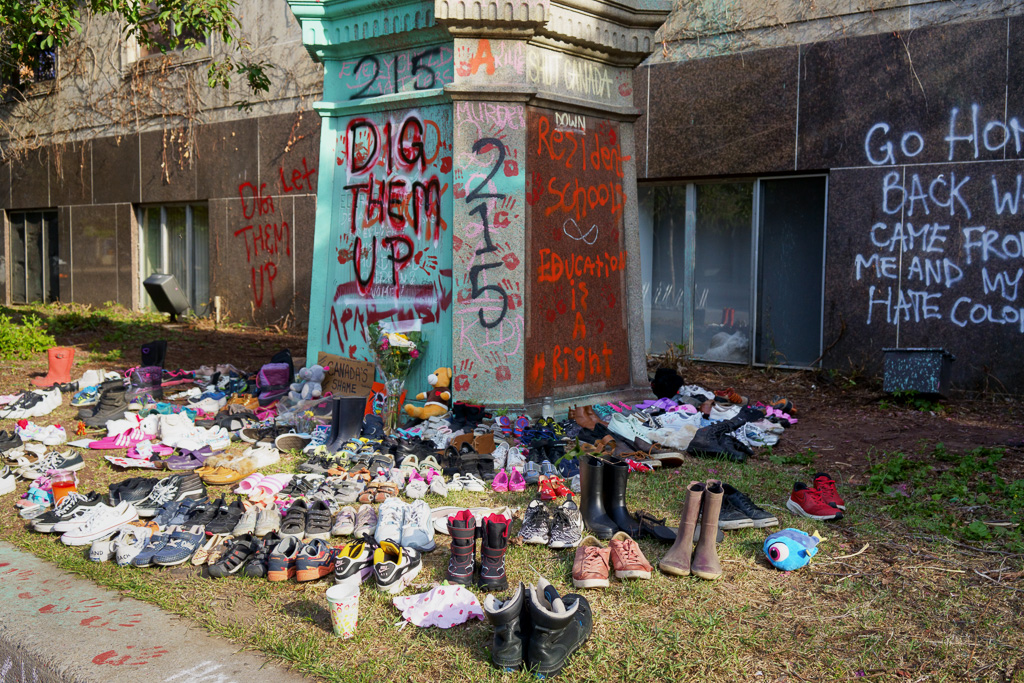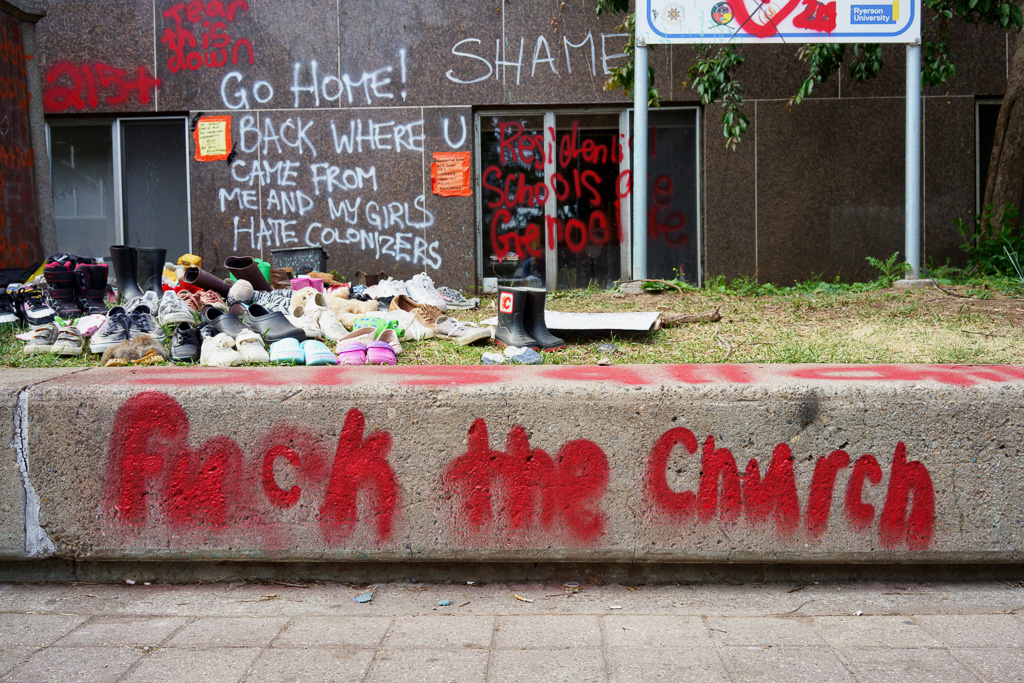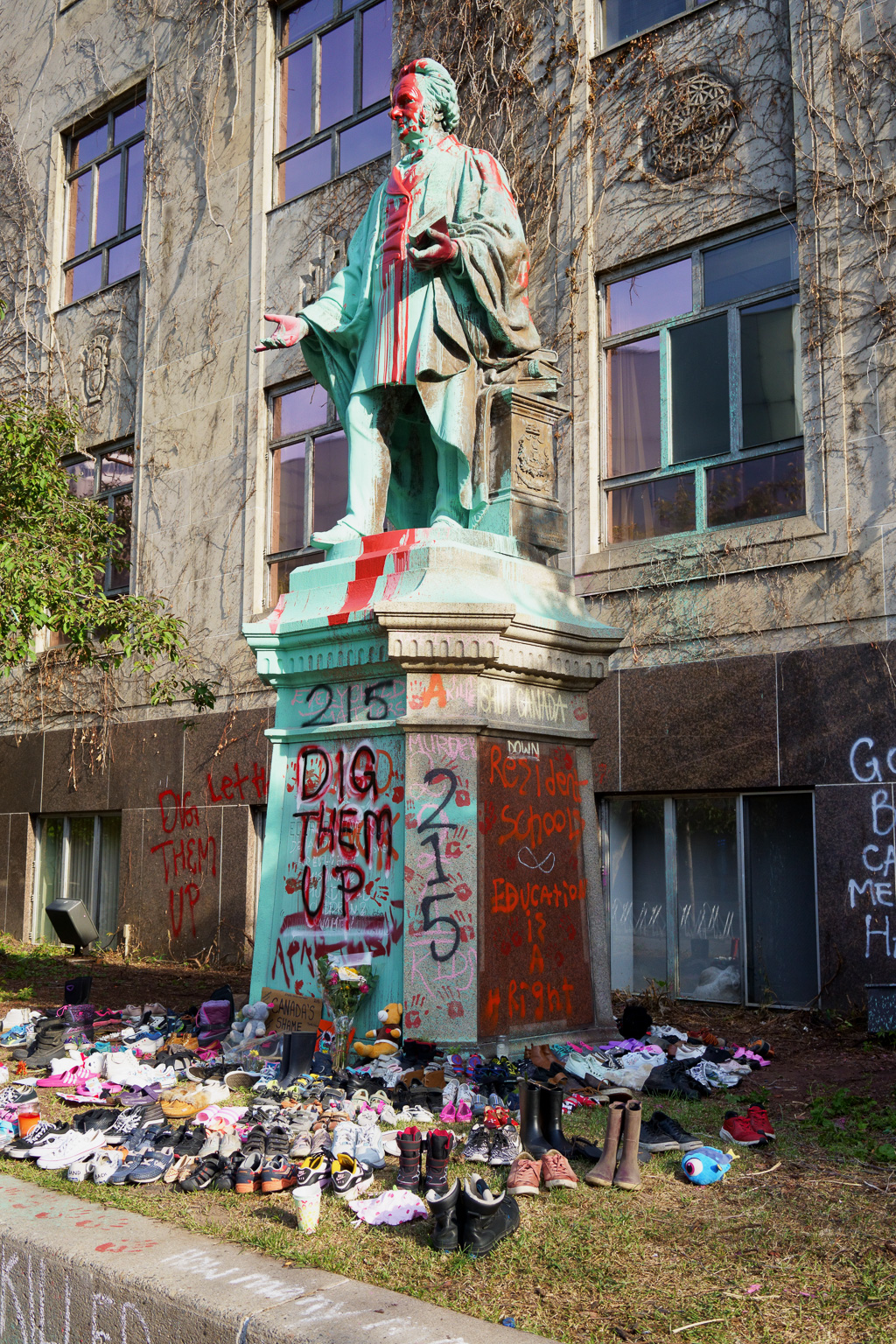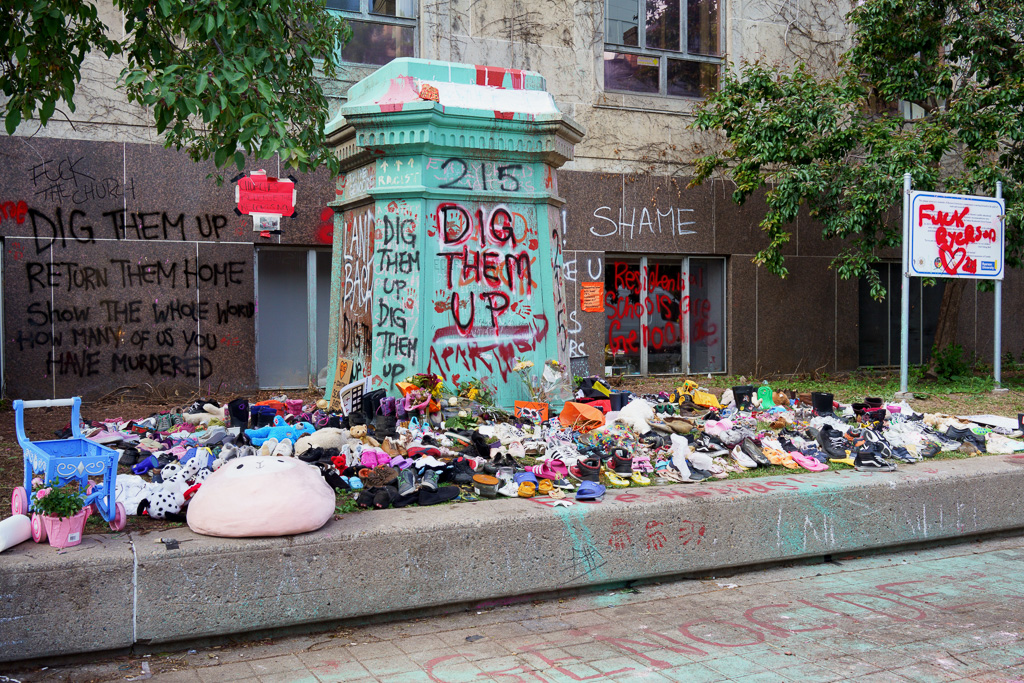On Sunday evening, people toppled the statue of Egerton Ryerson that stood on Gould Street in the middle of the Ryerson University Campus. For more than a year now, it’s been obvious that the statue’s days were numbered. Since May 27th, 2020, when Regis Korchinski-Paquet “fell” from her mother’s 24th floor balcony during a call by Toronto police, the statue has stood covered in red paint with spray-painted messages on the plinth. As Chief Superintendent of Education for Ontario, Ryerson was one of the architects of Canada’s residential school system which forcibly removed more than 150,000 First Nations children from their homes in order to prevent them from being raised and educated within their own cultures. By providing this practice with an intellectual rationale, Ryerson implicated himself in subsequent violence against First Nations children.
To its credit, the university’s administration didn’t try to cover things up. Instead, it posted a statement beside the statue acknowledging Ryerson’s complicity in racial violence and cultural genocide. It’s telling to contrast this response with the Ontario Government’s care of the John A. MacDonald statue which stands at the southern limit of Queen’s Park. Rather than address important issues, the government covered the statue in plywood and has been hoping ever since that the issue would just go away. Like a good authoritarian Donald Trump wannabe, Doug Ford has nothing to say about Residential Schools, or mercury poisoning at Grassy Narrows, or the provision of clean drinking water throughout the province. First Nations protesters are vandals and if they spray paint government property, then let them answer to the law.
215
Exactly one year after Korchinski-Paquet died, the Tk’emlúps te Secwépemc band located the remains of 215 children buried on the site of the former Kamloops Indian Residential School. People living there knew the remains existed but could not locate them until they used ground-penetrating radar equipment. This confirms repeated testimony of witnesses before the Indian Residential Schools Truth and Reconciliation Commission that such burial sites exist at many different former schools. However, authorities tended to treat such testimony dismissively. Murray Sinclair’s TRC report was published on November 15th, 2015 just 11 days after Justin Trudeau was sworn in as Canada’s 23rd prime minister. At that time, Trudeau had pledged to work to improve relations with First Nations Peoples. However, little in terms of concrete action has been committed by the federal government either under the Trudeau Liberals or their predecessors. Communities still struggle to obtain basics, like access to clean drinking water and appropriate housing. Little has been done to trace missing and murdered indigenous women. And no funds have been committed to locate graves of missing residential school students despite evidence that thousands of such graves exist.
By fortuitous timing, on June 1st, The Guardian published a long op-ed by Gary Younge: “Why every single statue should come down.” While he wrote with a Bristol statue in mind, his words are readily transferable to the Egerton Ryerson statue. I commend the article to readers who are seeking an intellectual hand grenade to lob into the midst of more conservative commentators who worry that knocking down statues represents an erasure of our history. Such commentators presume a positivist view of history, a fixed set of facts, like the atomic weight of argon, never subject to interpretation. But such a concern is incidental given that the function of a statue is only marginally tied to history; its primary function is to serve as an object of reverence. Statuary (of historical figures) is an expression of idolatry that serves the universal religion of our age: the dominance of capital over everything. In service of our true religion, Younge observes, statues “are erected with eternity in mind …”
When testing a notion to see if it holds up, I always go to the limit case. So when I wonder about the function of public monuments, I ask: what is the most egregious example of a public monument we humans have ever erected? What is the highest expression of our universal religion? Where have we pinned our most desperate hopes for immortality? It turns out we have built two such monuments, both completed in 1977.

The Golden Record
When I was a nerdy 14 years old, I considered it a viable possibility that I would one day become an astrophysicist. That hankering had been fueled for several years by a steady diet of science fiction novels, but in that particular year my imagination got a boost from the launch of the two Voyager missions. What gripped me about those missions was that not only would they fulfill a scientific function, but also they would serve as greetings from Earth to sentient creatures living on distant worlds. It was like the plot of an Arthur C. Clarke story. Under the leadership of Carl Sagan, a team developed The Golden Record, a durable greeting that included music, maps detailing the origins of the Voyager crafts, voice recordings in many languages, images, and of course technical drawings that would allow alien creatures to decode The Golden Record. Even as a teenager, what I found particularly sobering about the project is that, as Sagan made clear, The Golden Record will almost certainly survive the human species and, in fact, could well endure longer than the planet Earth. In spearheading this project, Carl Sagan had at least one eye on eternity.
More than 40 years later, both Voyager vessels have officially left the outer limits of our solar system and are now hurtling through deep space, Voyager 1 at a speed of 16.9 km/s and Voyager 2 at 15.2 km/s. I never did become an astrophysicist, gravitating (in a manner of speaking) toward more arts-related pursuits like music, literature and image-making. With this shift in personal interest and with the passage of time, I find myself returning to The Golden Record and wondering whether we (as represented by Carl Sagan’s committee) adequately interrogated what it was we thought we were doing when we assembled this greeting. Voyager 1 will pass within 1.6 light years of Gliese 445 in 40,000 years. After that, its next close interstellar encounter will happen 300,000 years from now as it flies within one light year of the M3V star TYC 3135-52-1. Even so, it has taken a casual observer like me only 40 years to recognize that our messages were culturally contingent expressions that were perhaps necessarily incapable of communicating what we hoped they would convey.
Consider the images that accompany The Golden Record. These aren’t the first snapshots of life on Earth that we sent towards interstellar space. Pioneers 10 and 11, launched in 1972 and 1973 respectively, include a plaque of gold anodized aluminum with pictographs of Earth’s location and inhabitants. Various articles describing the pictographs note that NASA received heavy criticism for depicting Earth’s inhabitants without clothes. None of those articles makes anything of the fact that those naked inhabitants are Caucasian. Etched on gold anodized aluminum, those same naked inhabitants are doubtless also blond. The images included on The Golden Record tried to be more inclusive although its naked paradigm was once again obviously Caucasian. What the selection committee explicitly refused to include were images depicting “war, poverty, disease, crime, ideology or religion” or, to put it in lay terms, anything that undermines attempts to make Earth look like a scene from a Disney film.
As I see it, there are a couple problems with the image selection criteria. First, it is dishonest in its representation of the way human beings manage their affairs on this here planet Earth. In particular, the exclusion of war, poverty, disease, and crime effectively excludes representation of the victims of war, poverty, disease, and crime. Overwhelmingly, those victims are racialized. A sanitized account of human experience ends up being a white account of human experience—a variation on the ‘history is the story told by the winners’ theme.
Second, at least with respect to the exclusion of ideology and religion from image selection, these criteria may well be impossible. The very act of listing six exclusionary categories is itself ideological. That aside, it is arguable that image-making is at its very heart an ideologically fraught activity. Framing a visual field forces us to include and to exclude and the criteria we apply to that decision-making engages us in choices that are expressions of value. The committee selected an image of male Olympic athletes running a race. Why male? Why a competition? Why not ordinary people of any gender simply running for pleasure? Why is the white-skinned runner out in front? Does that mean white-skinned runners are better than dark-skinned runners? Or maybe dark-skinned runners are predatory and the white-skinned runners are fleeing for their lives. Who knows how an alien viewer might interpret the image? The only thing we can say for certain about the alien viewer is that it is entitled to suppose that the image must signify something, otherwise we wouldn’t have selected it to bear whatever meanings we have foisted on it.
As for religion, The Golden Record includes an image of the Taj Mahal, the mausoleum for a man’s favourite wife. Even if it weren’t associated with a religion, it would still imply belief in an afterlife which is one of the chief features of religious belief. But the image implies more than we first suppose. The Taj Mahal’s construction required an economy (as does all collective activity) and, given other images of ordinary dwellings, we can safely assume that this building is somehow exceptional. As an exceptional building, it would place demands on the local economy. It’s mere existence implies inequality, perhaps even unjust social relations. As an alien viewer, I would want to know if humans had discovered a way to produce impressive monuments without exploiting great swaths of the labour market.
(As an aside, I would also wonder why this collection includes an image of Terminal One at the former Toronto International Airport. How is that representative of anything except a fetish for ugly concrete structures?)
I feel some sympathy for Carl Sagan and his committee. When we are presenting ourselves to someone else, whether that someone else is our next door neighbour or an alien creature in another star system, we want to cast ourselves in the best light. I understand how this works in matters of national identity. In the past, I have taken cover under my Canadian passport, making sure, especially when travelling in Europe, that people know I’m not American. We Canadians are nice. We Canadians are unsullied by an American brashness. We Canadians are compulsively apologetic. We like our stereotypes. What we don’t like is to hear is that we are the beneficiaries of a genocidal colonialism that has exploited Disneyfied stereotypes to evade responsibility. What we don’t like to hear is that the history we proudly tout is drenched in blood. What we don’t like to hear is that we’re no different than anyone else.

Cambodia
In 1986, poet, novelist, and cultural commentator, Brian Fawcett, published an odd mix of a book called Cambodia: a book for people who find television too slow in which he posed a simple question: What do we do about Cambodia? While Carl Sagan and his committee were curating The Golden Record for launch into interstellar space, Pol Pot and the Khmer Rouge were effecting the slaughter of Cambodian ethnic minorities, and anyone else who wasn’t prepared to join their great leap backward. In Fawcett’s lexicon, Cambodia stands for more than a genocide perpetrated by the Khmer Rouge during a four year period in the 1970’s. It stands for the attack on human thought, memory and imagination that lay at the heart of the Khmer Rouge’s methods. Killing people who had travelled abroad. Killing people who had read books. Killing people who wore glasses because they might be intellectuals. It also stands for the way the Cambodian genocide entered Western consciousness: it didn’t. When Fawcett asks What do we do about Cambodia? he is also asking How is Western culture—with its ADHD news cycle, its addiction to TV, and its generalized cultural Philistinism—complicit in the Khmer Rouge erasure of thought, memory and imagination? He turns to Marshall McLuhan’s Global Village, decrying its tendency to steamroll local concerns, supplanting them with plasticized images of a utopian neverland that looks vaguely like Manhattan.
If Fawcett were to come out with a 2nd edition of his book, he might call it Kamloops instead. Cambodia hit the book stands in 1986 when TV had been airing in Canada for 34 years. 34 years later, there’s little in Fawcett’s book that doesn’t still bear up under scrutiny. Our dominant medium has switched from EM bands to digital transmission allowing delivery of programming to happen on demand. Image resolution has increased dramatically. There has been an accelerating (con)fusion of the local and the global, news and entertainment, politics and bureaucracy. But the general drift remains unchanged. A 2nd edition would continue to document the creep of authoritarianism which silences independent thought, not by suffocating people with plastic bags, but by flooding our living rooms with Friends reunions.
Kamloops
The final piece in Brian Fawcett’s book is a fictionalized account of a train ride from Kamloops down to Vancouver. It’s titled “The Fat Family Goes to the World’s Fair”, a derisive encounter between two locals and a family of American tourists on their way to Expo ‘86. One of the locals convinces the tourists that the best exhibit at Expo isn’t on any of the official directories and is only advertised by word-of-mouth. They absolutely have to see the Cambodia exhibit. (Fawcett began his career as an urban planner and utterly despised Expo ‘86 and what it inflicted on Vancouver.) It is an odd coincidence that Fawcett’s Cambodia ends in Kamloops which is exactly where we need to be today.
In Kamloops (the imaginary book, not the town), it is impossible to treat the violence to Indigenous children in isolation of other important trends. One of those trends is the bureaucratization of social relations. Murray Sinclair dropped his six volume report onto Justin Trudeau’s lap who passed it along to the appropriate ministry where it settled like sedimentary effluvium into the soundless depths of a basement in downtown Ottawa. Everybody knows things need to change, but no one has any idea how to crank the administrative machinery into motion.
This is only the latest indignity in a succession of bureaucratic indignities that began with the creation of the residential school system in the first place. When examining Cambodia, and other genocidal regimes before it, Fawcett observes that they are egregiously inefficient. For example, the ostensible purpose of colonizing the Congo was to develop rubber plantations, but Belgium’s methods were wasteful and self-limiting. The same was true of Cambodia’s farming and irrigation projects which never produced enough even to sustain the workers. The ostensible purpose was never the purpose, and historians who talk about rubber production and farming are kidding themselves. There was only ever one purpose: the production of corpses.
The residential school system was no different. Its ostensible purpose was to produce Canadian citizens. But if that were true, why did so many of those schools starve their students? How is starvation an effective pedagogical method? The fact that the frontline administrators were religious institutions is besides the point. It was all part of a unitary power structure and an unholy one at that. 215 corpses in an unmarked mass grave wasn’t an aberration or collateral damage; it was the point.
Another of those trends relates to mass media. When Fawcett wrote Cambodia, the internet had no role in mass media, and participatory platforms—what we now call social media—were the stuff of science fiction. So a 2nd edition would have to take account of this development. Ten years ago, during the Arab Spring, social commentators touted Twitter in particular as a tool that would enable grassroots activism. However, that dream was short-lived when it became obvious that Twitter could just as easily be deployed in the opposite direction to suppress the activists. Now, Twitter appears to have sidestepped activism altogether. When news of Kamloops broke, people used Twitter primarily to vent outrage, as they did the week before when news broke of all the children in Gaza who had been killed by Israeli air-strikes. Twitter has become a virtual dildo, facilitating a masturbatory adrenaline rush but offering no meaningful opportunity for civic engagement. We have forgotten the children of Gaza, just as next week we will forget the children of Kamloops when our attention is distracted by the next inevitable outrage.
Egerton Ryerson
When we pull down a piece of public statuary, we engage in an iconoclasm that no tweet can ever accomplish. Curiously, the empty plinth leaves behind an absence that opens up space for a renewal of thought and memory. It is a creative gesture that allows us—all of us—to imagine fresh relationships.
The opening essay in Geoff Dyer’s new book, See/Saw, considers the photography of Eugène Atget and includes a passage about his photographs of statuary. He notes that the statuary are rooted in time, an observation that calls to mind Gary Younge’s assertion that statues are erected with eternity in mind. But Atget’s photographs coax the statues into a sentient state. Nevertheless, they remain time-bound, “mute witnesses to their own captivity.” Because they cannot move, all they can know is this languorous passage through time, gazing forever in one direction. Atget documents them contemplating—maybe even railing against—this fixity in space that has been visited upon them by their creators, long dead, who laboured in service of claims about permanence.
I take heart from this image of the statue tormented by its master’s delusions of eternal thinking. Tearing down a statue can liberate it from such a terror. Generous people can take its head and point its eyes at things it hasn’t gazed upon in a hundred years. They can even toss it into the lake where, slowly, it will vanish beneath accumulating sediments.

